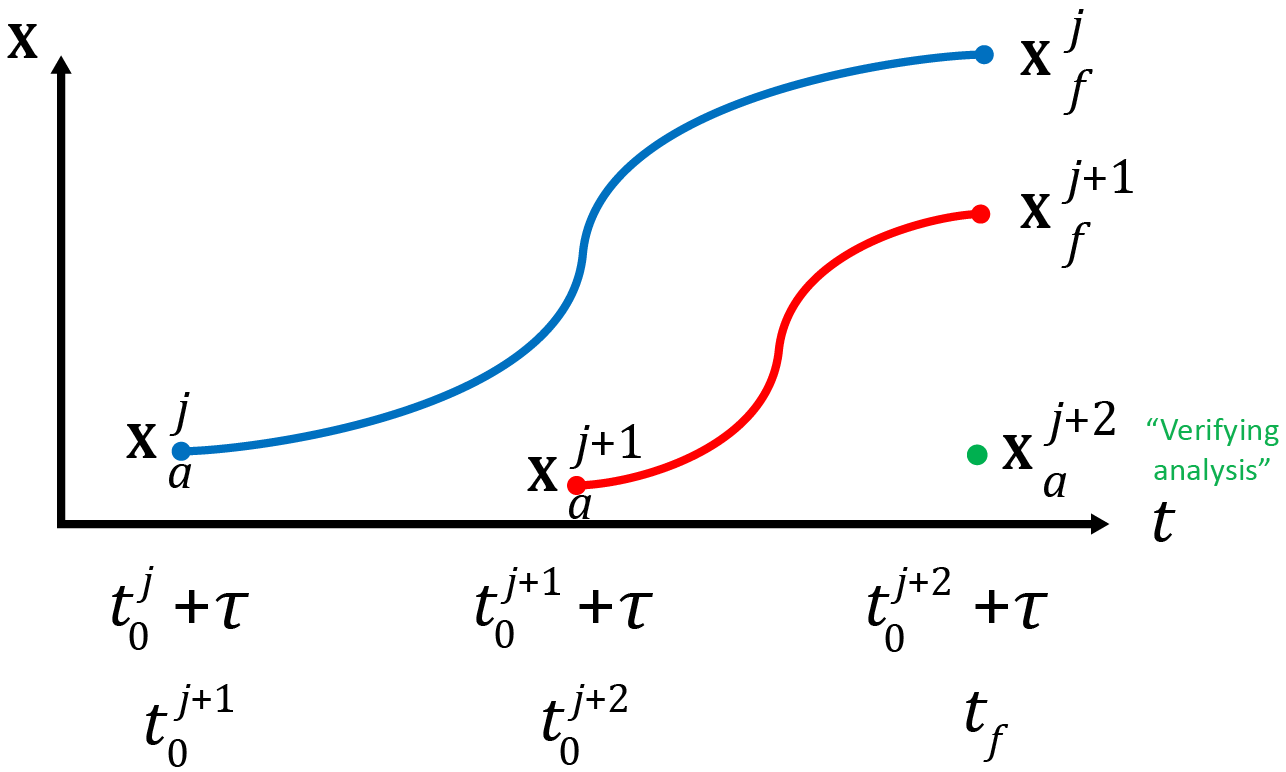Opened 6 years ago
Closed 6 years ago
#817 closed upgrade (Done)
Analysis-Forecast Observation Impacts driver
| Reported by: | arango | Owned by: | |
|---|---|---|---|
| Priority: | major | Milestone: | Release ROMS/TOMS 3.7 |
| Component: | Adjoint | Version: | 3.7 |
| Keywords: | Cc: |
Description
Added a new driver obs_sen_w4dpsas_forecast.h for computing observation impacts for the analysis-forecast cycle. It is activated with C-preprocessing option W4DPSAS_FCT_SENSITIVITY. It basically computes the impacts of each observation on the forecast error.
Added the tangent linear (tl_rpcg_lanczos.F) and adjoint (ad_rpcg_lanczos.F) versions of the Restricted B-preconditioned Conjugate Gradient Lanczos algorithm (known as RBLanczos or RPCG) used the 4D-Var dual formulation.
The following diagram is used to explain the forecast cycle observations impacts:
 For more information, check the following WikiROMS page. The red and blue curves show the typical configuration for the algorithm computing the analysis-forecast cycle observation impacts.
For more information, check the following WikiROMS page. The red and blue curves show the typical configuration for the algorithm computing the analysis-forecast cycle observation impacts.
The observation impacts can be forced at the model grid points, defining the desired metrics or at the observation locations when OBS_SPACE is activated additionally.
WARNINGS:
Both the roms.in and s4dvar.in scripts were modified to add new parameters needed in them analysis-forecast cycle observation impacts configuration:
- In ocean.in, we have:
! Number of timesteps for computing observation impacts during the ! analysis-forecast cycle. NTIMES_ANA == 1440 ! analysis interval NTIMES_FCT == 1440 ! forecast interval ... ! Input adjoint forcing NetCDF filenames for computing observations ! impacts during the analysis-forecast cycle. If the forecast error ! metric is defined in state-space, then FOInameA and FOInameB should ! be regular adjoint forcing files just like ADSname. If the forecast ! error metric is defined in observation space (OBS_SPACE is activated) ! then the forecast is initialized OIFnameA and OIFnameB (specified in ! s4dva4.in input script) will have the structure of a 4D-Var observation ! file. FOInameA == roms_foi_a.nc FOInameB == roms_foi_b.nc ! Input NetCDF filenames for the forecasts initialized from the analysis ! of the current 4D-Var cycle (FCTnameA) and initialized from the analysis ! of the previous 4D-Var cycle (FCTnameB). FCTnameA == roms_fct_a.nc FCTnameB == roms_fct_b.ncWhere NTIMES_ANA and NTIMES_FCT are the total number of timesteps to compute the observations-impacts interval during the analysis and forecast cycle, respectively, when W4DPSAS_FCT_SENSITIVITY is activated.
FOInameA and FOInameB are the input forcing NetCDF files at model grid points for computing the observation impact when the forecast is initialized with the 4D-Var analysis (red curve) or the 4D-Var background (blue curves), respectively. FCTnameA is the current 4D-Var analysis cycle (red curve) and FCTnameB is the previous 4D-Var analysis cycle (blue curve).
- In s4dvar.in, we have:
! Input forcing filenames at observation locations for computing observations ! impacts during the analysis-forecast cycle when the forecast is initialized ! with the 4D-Var analysis (OIFnameA) or the 4D-Var background (OIFnameB). OIFnameA == roms_oif_a.nc OIFnameB == roms_oif_b.ncwere OIFnameA and OIFnameB are the input forcing NetCDF files at observation location for computing the observation impact when the forecast is initialized with the 4D-Var analysis (red curve) or the 4D-Var background (blue curves), respectively, when both W4DPSAS_FCT_SENSITIVITY and OBS_SPACE options are activates.
References:
Errico, R.M., 2007: Interpretations of an adjoint-derived observational impact measure, Tellus, 59A, 273-276.
Gelaro, R., Y. Zhu, R.M. Errico, 2007: Examination of various-order adjoint-based approximations of observation impact, Meteorologische Zeitschrift, 16, 685-692.
Langland, R.H. and N.Baker, 2004: Estimation of observation impact using the NRL atmospheric variational data assimilation adjoint system, Tellus, 56, 189-201.
Many thanks to Andy Moore for his help coding and testing this complex algorithm. There are involved technical description that will be published in the near feature with realistic applications.
